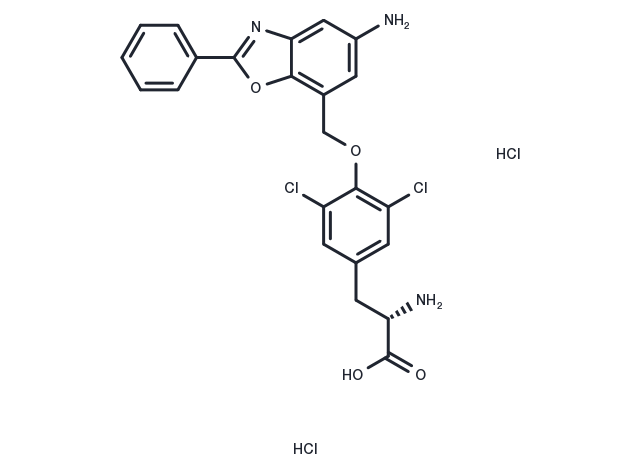Powder: -20°C for 3 years | In solvent: -80°C for 1 year


JPH203 dihydrochloride (KYT-0353 dihydrochloride) is a tyrosine analog, acts as a selective inhibitor of L-type amino acid transporter 1 (LAT1), and is used in cancer research.

| Pack Size | Availability | Price/USD | Quantity |
|---|---|---|---|
| 1 mg | In stock | $ 109.00 | |
| 2 mg | In stock | $ 162.00 | |
| 5 mg | In stock | $ 198.00 | |
| 10 mg | In stock | $ 297.00 | |
| 25 mg | In stock | $ 483.00 | |
| 50 mg | In stock | $ 690.00 | |
| 100 mg | In stock | $ 982.00 | |
| 1 mL * 10 mM (in DMSO) | In stock | $ 297.00 |




| Description | JPH203 dihydrochloride (KYT-0353 dihydrochloride) is a tyrosine analog, acts as a selective inhibitor of L-type amino acid transporter 1 (LAT1), and is used in cancer research. |
| In vitro | JPH203 (30 mM) induces mitochondria-dependent apoptosis in Saos2 human osteosarcoma cells. JPH203 (0.001-100 μM) inhibits 14C-leucine (1.0 μM) uptake slightly in FOB cells with an IC50 value of 92.12 ± 10.71 μM, but potently exihibts such effects in Saos2 cells with an IC50 value of 1.31 ± 0.27 μM. JPH203 (0.01 to 30 mM, 1-4 d) potently inhibits cell proliferation in Saos2 cells in a dose- and time-dependent manner, with an IC50 of 4.09-0.09 mM, but slightly inhibits that of FOB cells, with an IC50 of 24.1-2.8 mM.JPH203 Dihydrochloride is a selective inhibitor of LAT1. JPH203 inhibits 14C-leucine uptake in S2-hLAT1 and HT-29 cells, with IC50s of 0.14 μM and 0.06 μM. JPH203 (3-1000 μM) exhibits concentration-dependent inhibitory effects on S2-hLAT1 cell growth with an IC50 of 16.4 μM. JPH203 also displays inhibitory activities against HT-29 cell growth, with an IC50 value of 4.1 μM. JPH203 (0.001-100 μM) inhibits the 14C-leucine (1.0 μM) uptake in a concentration dependent way by the YD-38 cells with an IC50 value of 0.79 ± 0.06 μM. JPH203 slightly shows such effects in normal human oral keratinocytes (NHOKs). JPH203 (0.01-30 mM, 1-4 d) completely inhibits the proliferation of YD-38 cells in a dose- and time-dependent manner. However, JPH203 slightly inhibits the proliferation of NHOKs. JPH203 (30 mM) induces apoptosis of YD-38 cells. JPH203 (3 mM) also increases the level of cleaved PARP in activation of the caspases cascade. |
| In vivo | JPH203 exhibits dose-dependent inhibition on HT-29 tumor growth in nude mice. |
| Synonyms | KYT-0353 dihydrochloride |
| Molecular Weight | 545.24 |
| Formula | C23H21Cl4N3O4 |
| CAS No. | 1597402-27-1 |
Powder: -20°C for 3 years | In solvent: -80°C for 1 year
DMSO: 50 mg/mL (91.70 mM), Sonification is recommended.
H2O: 10mg/mL (18.34mM)
You can also refer to dose conversion for different animals. More
bottom
Please see Inhibitor Handling Instructions for more frequently ask questions. Topics include: how to prepare stock solutions, how to store products, and cautions on cell-based assays & animal experiments, etc.
JPH203 dihydrochloride 1597402-27-1 Others JPH 203 JPH-203 KYT 0353 KYT-0353 Dihydrochloride JPH-203 Dihydrochloride JPH-203 dihydrochloride KYT-0353 JPH203 Dihydrochloride KYT0353 KYT0353 Dihydrochloride KYT-0353 dihydrochloride JPH 203 Dihydrochloride KYT 0353 Dihydrochloride JPH203 inhibitor inhibit
